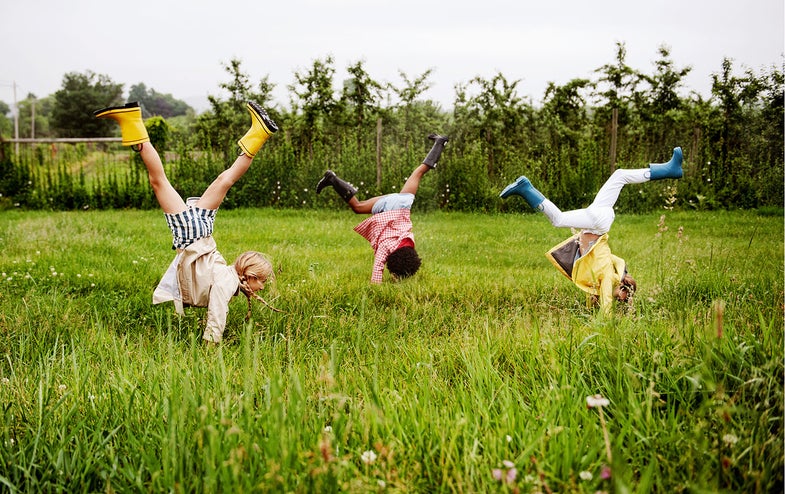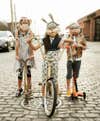Tips From a Pro: Shoot Kid Photography That’s Authentic, Not Cheesy
Zoe Berkovic, one of the country’s busiest and best child photographers lets us in on her tips and secrets.


“It’s funny that people who don’t have much experience photographing kids imagine that it’s the hardest kind of portraiture there is,” says Zoe Berkovic, a New York-based fashion and advertising photographer who specializes in working with children. “For me, that’s not true, though. If you like the company of children and you enjoy connecting with them, it can be a blast.”
Her subjects haven’t yet developed “the protective walls that adults sometimes build up around themselves. I see them as fully realized people with a genuine range of emotions and vast inner landscapes. Once they sense that I get that, kids are easy to work with,” she explains.
Photo sessions with kids need to feel breezy and natural because, if the kids are too hyped up, they’re likely to burn out before you’re finished shooting. To keep the mood relaxed, you’ve got to stay relaxed too. “If you are, the kids will sense it. Let them be themselves while you try connecting with them using a gentle tone, eye contact, and, most of all, respect. They will respond in kind,” says the photographer.
If you’re sensitive to what the children around you are experiencing and feeling, it will help you recognize, respond to, and capture the behaviors they’re likely to produce for you.
But keep your shoot active. You want to keep the kids connected and engaged with what’s happening around them. Providing some form of entertainment can help. “When things start to slow down, I pull out my Elmo and Mickey Mouse impersonations. Or I pretend to cry hysterically or laugh like a maniac,” Berkovic says. “These types of practiced routines are often enough to hold kids’ interest, at least for a while.”

On the Set
Choose locations that are calm, quiet, and familiar. “If you have it, a place that offers lots of space for the child to move around in will up your chances of having a happy, calm subject,” the photographer advises.
“Shoot where the light is good and the background can help you tell a story or set a consistent tone, without distraction. I like shooting at a location that takes my subjects away from everyday life—one that transports them somewhere more magical than their everyday reality,” she adds. It’s a good way to keep boredom or distraction at bay.
Berkovic also prefers spaces that have white walls. “It lets me use just one strobe to the side of the kids and opposite that wall,” she notes. The wall will act as a white reflector to fill in shadows. You can also use it to create shadows that add interest and depth, and to give kids something to lean on, which can introduce colorful body language.

Always fit the shoot to the child. As part of a photo session’s preplanning stage, Berkovic tries to devise a shoot that will suit the personality of the individual child. “For ad work, I like to be involved in casting the kids because I know which would be a good fit for a particular job. Some have great dispositions and others tend to be moody. I love both personalities, but both types usually won’t work for every job. I’m sensitive to what’s required, and try to match the child to the project. It sets me up for success,” she says.
If you want to photograph your own children, the good news is that no one knows them better than you do. Don’t let the photo session play against type, and select appropriately child-specific locations, times of day, clothing, poses, props, and direction.
While the shoot is underway, observe your subjects and try to get on their wavelength. Every child is different. The same child can change mood across any given day—or minute! “The trick is paying attention and realizing when your subjects are close to burning out and releasing them or giving them breaks before they reach that point. Most kids four years and up can last, with breaks, for four hours or more,” says Berkovic.

Don’t go into a shoot with too many preconceptions or expectations, and keep your goals to a minimum. Berkovic limits hers to this: “I want these kids to show me authenticity and soul. To find those qualities, I gently direct them, all the time being open to spontaneously generated opportunities and the unexpected. Witnessing and enjoying these unexpected moments are actually what makes my job fun and rewarding,” she says.
Planning is essential. “Have everything in place in advance so that you’re ready to capture these moments as soon as the session starts. Have games set up and conversational topics ready. If possible, have a child wrangler who is known, trusted, and who can entertain the child while you’re concentrating on other things,” says the photographer.
When kids get cranky, Berkovic doesn’t see their mood as a problem, but as an opportunity. “I’m not opposed to kids feeling emotions other than happiness. I can play around with expressions, because my goal isn’t to get smiley portraits. I let the kids be themselves and don’t make them feel that any behavior they show me is ‘wrong,’” she insists. Giving children the liberty to be themselves pays off for her in the long run.
When grumpy behavior threatens to derail a shoot, though, “I step back and let the child wrangler work his or her magic. And if that fails, I sometimes have backup kids on set, especially for toddlers and babies,” she says. As a parent, you won’t have “backup” kids, but your subject may have older, more willing siblings, and at such moments you should be prepared to turn the focus on them.

Nuts and Bolts
As for camera gear, Berkovic shoots with DSLRs from both Canon and Nikon, and she relies on pro-level models for all the usual reasons—speed, durability, image quality, ability to work well in both available light and strobe-lit settings. Her favorite lens is Nikon’s 24–70mm f/2.8G Nikkor AF ED VR, which she likes for its shake control and focal length. At 24mm, it lets her include a lot of background detail, while at its 70mm long end, she can zoom in for a tight crop on a face or figure. “I’m less interested in the gear than I am in the lighting and the story I want to tell,” she says.
Berkovic fell into professional child photography about a decade ago. “I was coming off a failed business, picked up a point-and-shoot camera, and decided to give photography a try,” says Berkovic. “I took every book on photography out of the library, soaked up all the information I could online, and then hit the ground running. I haven’t stopped since.”
She started with family photography, at first finding her clients among her own circle. She also cultivated relationships with teachers and mentors from whom she learned the basics of lighting, composition, editing, working with color, best business practices, pricing, casting techniques, and wardrobe styling. She needed solid knowledge of all these to succeed in the field.

Although she hadn’t planned it, her business has changed. “I noticed over time that I loved images that told stories and conveyed emotions. I was attracted to a wide variety of locations, compositions, lighting setups, and moods that weren’t always appropriate for typical family portraits,” Berkovic says. This prompted her to leap to advertising, kids’ fashion, and child-focused editorial photography.
Interested in attempting a portrait session with your own children? Many pros believe that photographing your kids is often the hardest kind of child portraiture. For one thing, kids can be reluctant subjects for their parents. If this sounds like your situation, fighting it probably won’t get you great pictures. Instead, learn the strategies and techniques of child photography by working with other people’s children—with their parents’ express permission, of course.
Berkovic herself loves the work and invites anyone who’s interested to give it a go. “If you’re like me, you will love the spontaneity of working with kids and the many unexpected pleasures they will surprise you with along the way. This job is definitely not easy, but it sure is fun!”


